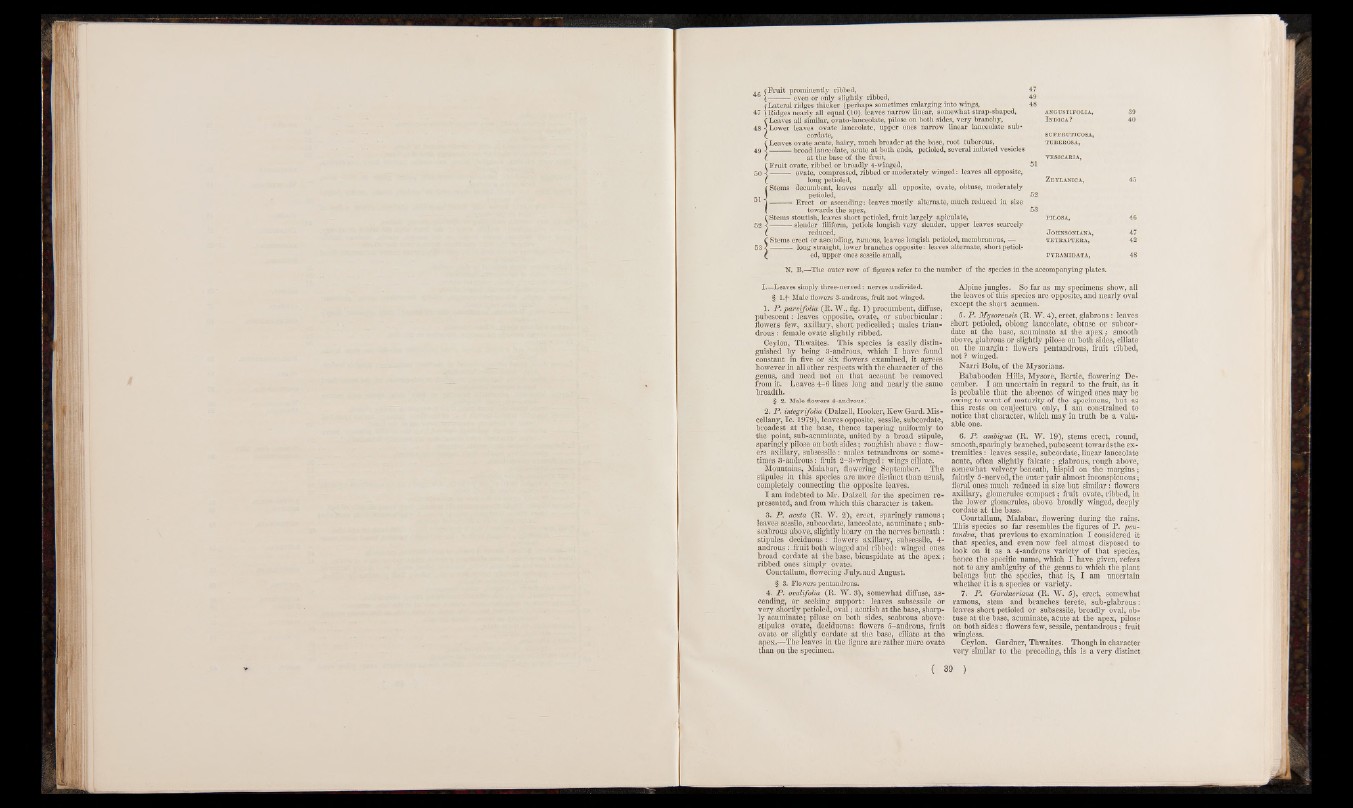
. . f Fruit prominently ribbed,
4b ( -----— even or only slightly ribbed,
c Lateral ridges thicker (perhaps sometimes enlarging into wings,
47 (Ridges nearly all equal (10), leaves narrow linear, somewhat strap-shaped,
r Leaves all similar, ovato-lanceolate, pilose on both sides, very branchy,
48 \ Lower leaves ovate lanceolate, upper ones narrow linear lanceolate sub-
( cordate,
(Leaves ovate acute, hairy, much broader at the base, root tuberous,
49 -3-------- broad lanceolate, acute at both ends, petioled, several inflated vesicles
f at the base of the fruit,
( Fruit ovate, ribbed or broadly 4-winged,
50 -<------- - ovate, compressed, ribbed or moderately winged: leaves all opposite,
{( - long petioled, Stems decumbent, leaves nearly all opposite, ovate, obtuse, moderately
petioled,
-------- Erect or ascending: leaves mostly alternate, much reduced in size
towards the apex, S Stems stoutish, leaves short petioled, fruit largely apicplate,
-------- slender filiform, petiols longish very slender, upper leaves scarcely
reduced,
( Stems erect or ascending, ramous, leaves longish petioled, membranous, —
53 / -------- long straight, lower branches opposite: leaves alternate, short petiol-
( ed, upper ones sessile small,
47
49
48
51
53
ANGTT8T1F0L1A,
I njdica?
SOFFRUTICOSA,
TUBEKOSA,
VESICARIA,
Z eylanica,
PILOSA,
JOHNSONIANA,
TETRAPTERA,
PYRAMID ATA,
N.B.—The outer row of figures refer to the number of the species in the accompanying plates.
39
40
45
48
I.—Leaves simply three-nerved: nerves undivided.
§ l.f Male flowers 3-androus, fruit not winged.
1. P.parvifolia (R. W.,fig. 1) procumbent, diffuse,
pubescent: leaves opposite, ovate, or suborbicular:
flowers few, axillary, short pedicelled; males trian-
drous: female ovate slightly ribbed.
Ceylon, Thwaites. This species is easily distinguished
by being 3-androus, which I have found
constant in five or six flowers examined, it agrees
however in all other respects'with the character of the
genus, and need not on that account be removed
from it. Leaves 4-6 lines long and nearly the same
breadth.
§ 2. Male flowers 4-androus.'
2. P . integrifolia (Dalzell, Hooker, Kew Gard. Miscellany,
Ic. 1979), leaves opposite, sessile, subcordate,
broadest at the base, thence tapering uniformly to
the point, sub-acuminate, united by a broad stipule,
sparingly pilose on both sides; roughish above: flowers
axillary, subsessile: males tetrandrous or sometimes
3-androus: fruit 2-3-winged: wings ciliate.
Mountains, Malabar, flowering September. The
stipules in this species are more distinct than usual,
completely connecting the opposite leaves.
I am indebted to Mr. Dalzell for the specimen represented,
and from which this character is taken.
3. P . acuta (R. W. 2), erect, sparingly ramous;
leaves sessile, subcordate, lanceolate, acuminate; sub-
scabrous above, slightly hoary on the nerves beneath:
stipules deciduous: flowers axillary, subsessile, 4-
androus : fr u it both winged and ribbed: winged ones
broad cordate at the base, bicuspidate at the ap e x ;
ribbed ones simply ovate.
Courtallum, flowering July, and August.
§ 3. Flowers pentandrous.
4. P . ovalifolia (R. W. 3), somewhat diffuse, ascending,
or seeking support: leaves subsessile or
very shortly petioled, oval; acutish at the base, sharply
acuminate; pilose on both sides, scabrous above:
stipules ovate, deciduous: flowers 5-androus, fruit
ovate or slightly cordate at the base, ciliate at the
apex.—The leaves in the figure are rather more ovate
than on the specimen.
Alpine jungles. So far as my specimens show, all
the leaves of this species are opposite, and nearly oval
except the short acumen.
5. P . Mysorensis (R. W . 4), erect, glabrous: leaves
short petioled, oblong lanceolate, obtuse or subcordate
at the base, acuminate at the apex,* smooth
above, glabrous or slightly pilose on both sides, ciliate
on the margin: flowers pentandrous, fruit ribbed,
not? winged.
Karri Bolu, of the Mysorians.
Bababooden Hills, Mysore, Bertie, flowering December.
I am uncertain in regard to the fruit, as it
is probable that the absence of winged ones may be
owing to want of maturity of the specimens, but as
this rests on conjecture only, I am constrained to
notice that character, which may in truth be a valuable
one.
6. P . ambigua (R. W. 19), stems erect, round,
smooth, sparingly branched, pubescent towards the extremities
: leaves sessile, subcordate, linear lanceolate
acute, often slightly falcate; glabrous, rough above,
somewhat velvety beneath, hispid on the margins;
faintly 5-nerved, the outer pair almost inconspicuous;
floral ones much reduced in size but similar: flowers
axillary, glomerules compact; fruit ovate, ribbed, in
the lower glomerules, above broadly winged, deeply
cordate at the base.
Cotu*tallum, Malabar, flowering during the rains.
This species so far resembles the figures of P. pen-
tandra, that previous to examination I considered it
that species, and even now feel almost disposed to
look on it as a 4-androus variety of that species,
hence the specific name, which I have given, refers
not to any ambiguity of the genus to which the plant
belongs but the species, that is, I am uncertain
whether it is a species or variety.
7. P . Gardneriana (R. W. 5), erect, somewhat
ramous, stem and branches terete, sub-glabrous:
leaves short petioled or subsessile, broadly oval, obtuse
at the base, acuminate, acute at the apex, pilose
on both sides: flowers few, sessile, pentandrous; fruit
wingless.
Ceylon. Gardner, Thwaites. Though in character
very similar to the preceding, this is a very distinct